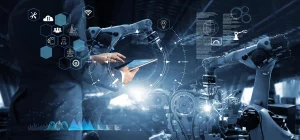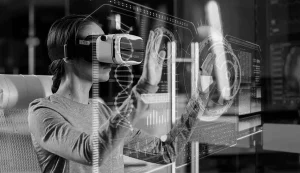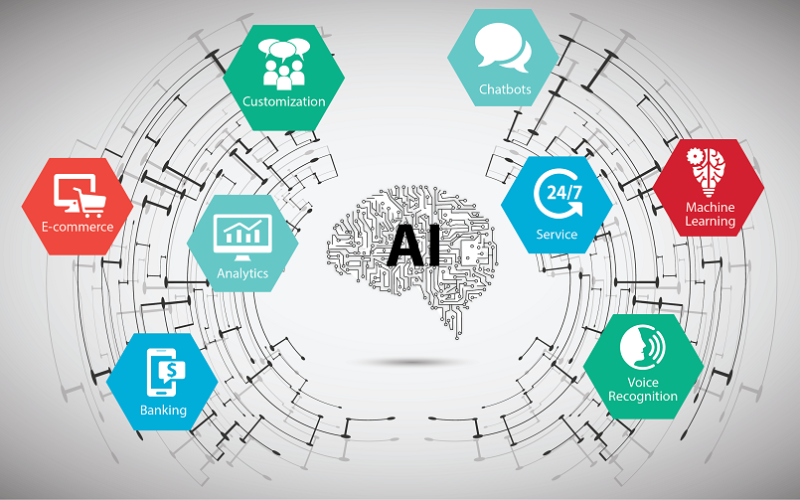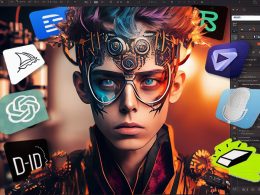Artificial Intelligence (AI) is automating a lot of sectors, and they’re also transforming the creative industries. As technology gets better, AI gets the ability to support artist role, designers, musicians, and many other creative types of the same character. This piece looks at the future of AI in creative industries and tries to show what people can benefit from this, in the end, the applications that are possible and real examples.
The Growing Influence of AI in Creative Fields
The creative world has been reinvigorated with AI’s arrival, is offering endless possibilities and strengthening many of the existing processes. These are some of the major areas where AI is making a significant impact on the creative world:
- Visual Arts
- Music Production
- Film and Video Production
- Writing and Content Creation
- Advertising and Marketing
- Fashion and Design
Benefits of AI in Creative Industries

1. Enhanced Efficiency and Productivity
AI-powered tools can take over monotonous activities, authors can then focus on the more abstract side of things and express their creativity. For example, AI can find multiple variations in design, make photo edits or even create simple music compositions in ten minutes, as opposed to thirty that would be needed if a musician had to do everything by hand.
2. Improved Personalization
Artificial intelligence algorithms have the ability to go through enough data to find out what exactly people like to see and read. After that, they would be able to make the results so relevant and interesting that people would interact more with those advertisements and content.
3. Expanded Creative Possibilities
AI opens creative minds to a new level of visual storytelling and industrial innovation with the latest technologies created by others. AI, for instance, can produce new color schemes not yet imagined by human designers, generate unique creative elements or instead, bring forth art, which has never existed before.
4. Cost Reduction
About 80 % of the costs of production can be paid by any businesses using automating technologies in the creative industries. The savings are mainly for the startups that operate with limited resources and individuals who work alone.
5. Data-Driven Decision Making
AI models can examine and come up with theories of the market, customer behavior, and business performance thus gaining insights that are crucial for decision making. This approach, led by data, can help designers, whether fashion or print, decide about their projects and the strategies to use.
Case Studies and Examples
1. Visual Arts: AI-Generated Artwork
In 2018, AI didn’t actually paint the picture itself but it had a significant role in the process of creating a unique artwork called “Edmond de Belamy” which was sold for $432,000. Obvious, the group that did this, demonstrated, with the above-mentioned event, how AI could be used in the art world successfully. A lot of the artists have included some AIs in their creative processes such as GANs (Generative Adversarial Networks) that are used to create the one-of-a-kind art pieces.
2. Music: AI-Assisted Composition
Artificial Intelligence Virtual Artist (AIVA) is the name of the first AI composer that was the author of music for different commercials, video games, and films. Then, in 2016, the music society SACEM accepted AIVA as the first non-human member. These days, what many musicians do is acquire tools in sequence with their creative process, AI music software like AIVA is then used for composing melodies either from scratch or from the base sequences initiated by musicians.
3. Film: AI in Visual Effects
The use of AI in the film industry has become an unstoppable trend in effects productions. To cite an example, Disney Research has come up with an AI app called Face Re-aging Network (FRAN) that humanizes the process of age adjustment, i.e., it realistically and tactlessly ages or de-ages actors incredibly compared with previous years. This software technology was involved in the film “The Irishman,” it recreated the characters making the actors appear younger. The process was less time-consuming and therefore cheaper because it was not done using old CGI techniques.
4. Writing: AI-Powered Content Creation
The GPT-3 language model developed by OpenAI has demonstrated some amazing capabilities like being able to generate text that is very much like a human’s writing style. GPT-3 crafted a complete on the things related to artificial intelligence, which is then corrected by the human writers. Machine learning is still a green concept and does not completely take the place of humans in the case of writing but still, help in doing a number of things such as headlines writing, content summarizing, or even providing writing prompts.
5. Advertising: Personalized Marketing Campaigns

The self-service soft drink fountains data which was obtained through AI was also used by Coca-Cola to get the required information about the good taste of the new flavor combinations. Moreover, Cherry Sprite was created and achieved sales success. The use of AI-based marketing tools among others, can help create ad copy that reflects the customer’s tastes, discover the best ad placements, and even predict campaign performance.
The Future Landscape of AI in Creative Industries
1. Collaboration Between Humans and AI
AI will emerge differently and we are likely to see many projects that have been worked on together by humans and computers. Robots or AI can at best be assumed to assist in the creative process by acting as assistants to human intelligence rather than to act as independent creators. This breakdown of the collaboration as termed by industry insiders is predicted to change the way art, music and stories are made as they will be enhanced with AI-generated components.
2. Ethical Considerations and Copyright Issues
The ability of AI to bring untold opportunities and bigger numbers in success right in content creation is still a major issue for the creative industry. Problems connected to new techniques should be addressed, particularly to respect copyright. Therefore, some responsibility should be given to the professionals in the entertainment industry to figure out the norms and regulations which they all have to adhere to so that all are treated fairly.
3. Democratization of Creativity
It is the very clear potential of the AI tools in bringing the creative process to the public that is the most promising. Everyone will be able to produce professional quality film, video, and audio only if they are allowed to use, or to hire someone with a certain level of expertise to operate the using of such user-friendly and economically affordable software tools. In this way, the different types of creative lacunae may be filled.
4. New Job Roles and Skill Requirements
The creative sector can look forward to a larger number of job availabilities since AI solutions will bring the need for some new positions in the field such as AI art directors or AI music producers. The role of a contemporary creative person should be analyzed, as s/he would be expected to have skills of a programmer or a robotics engineer instead of being an artist alone.
5. Advancements in Virtual and Augmented Reality

Virtual and augmented reality technologies have recently evolved to allow AI to be the core of more authentic, stronger, and interactive experiences. These solutions have the potential to take gaming, architecture, and interactive storytelling to a whole new level of advancement.
Challenges and Considerations
1. Maintaining Human Creativity and Originality
The endangered presence of human creativity in scenarios featuring the wide application of AI creates an imperative need for safeguarding the human imprint and originality. There is also the second thing that needs to be taken into consideration, the belief that human creations have to keep their uniqueness and up to certain levels of artificial support.
2. Addressing Bias in AI Systems
AI systems that contain biases from their learning data can be extremely damaging. In some creative areas, this can lead to negative representation of certain groups or misrepresentation of diverse views. The tools to be developed should consider the existence and needs of multicultural societies.
3. Ensuring Data Privacy and Security
AI systems need a lot of data to run which makes the protection of the user’s privacy and the secrecy of the sensitive information crucial. The industries involved in creating will have the challenge to instill the right data governance practices and know-clear policies will be used in data use.
4. Adapting Education and Training
Education and training programs in the creative sector are expected to undergo a radical transformation incorporating relevant AI-related skills and knowledge. This will enable the workforce to develop skills and expertise to not only manage but also to thrive in the age of AI-powered tools and systems.
Conclusion
The innovations in the creative industry brought by AI are not merely the solutions to a set of problems but are filled with the potential of amazing growth and development. As AI becomes more and more advanced, its rapid transformation in the media and arts sectors will, inexorably, change the modes of artistic creations. By way of utilizing AI’s potential and solving the problems that accompany it, the artists/designers/writers/actresses can use this modern technology to entice them to go out of their comfort zone and create something that is truly groundbreaking.
The essential feature that one requires to triumph in the AI-dominated future is to merge a human touch with the very wide extravagance of artificial knowledge. The companies have to strive for those who are willing to adjust, transform, and grow up and at the same time delve into new innovations. Meanwhile, they have to keep the human element of the art and creativity as charm to the products for they have the magic of transforming a regular art piece into poetry, thus excelling in both.










